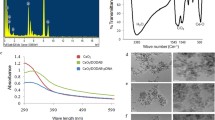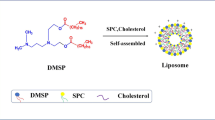Abstract
Purpose. This study tests the hypothesis that gene transfer efficiency may be improved through the use of transiently stable transfection complexes that degrade within endosomal compartments and promote plasmid escape into the cytosol.
Method. An acid labile cationic lipid, O-(2R-1,2-di-O-(1`Z, 9`Z-octadecadienyl)-glycerol)-3-N-(bis-2-aminoethyl)-carbamate (BCAT), was designed, synthesized, and tested for enhanced gene transfer activity relative to non-labile controls.
Results. The O-alkenyl chains of BCAT were completely hydrolyzed after 4 h incubation in pH 4.5 buffer at 25°C. Addition of BCAT to plasmid DNA in 40%ethanol followed by ethanol evaporation yielded transfection complexes that transfected several cell types in the presence of fetal calf serum and without the need of a helper lipid. Transfection complexes prepared from BCAT displayed higher luciferase expression than the corresponding DCAT complexes (an acid-insensitive derivative of BCAT) for all cell types tested. Uptake studies showed that this increase was not due to a difference in the amount of DNA being delivered. FACS analysis for GFP expression showed that BCAT transfection complexes yielded 1.6 more transfected cells and 20%higher log mean fluorescence than DCAT transfection complexes. In vivo gene transfer was demonstrated in subcutaneous tumor-bearing mice by systemic administration of a 60 μg plasmid dose. Expression was observed in the lungs and in the tumor, with the highest activity being observed in the lungs.
Conclusions. Our results show that increased transfection can be obtained by coupling the cationic headgroup to the hydrophobic amphiphilic tails via acid-labile bonds. Acid-catalyzed release of the alkyl chains should facilitate dissociation of the cationic lipid headgroup from the plasmid, thus accelerating one of the rate-limiting steps in cationic lipid mediated transfection.
Similar content being viewed by others
REFERENCES
M. S. Horwitz. Adenoviridae and Their Replication. Raven Press, New York, 1990.
A. P. Rolland. From genes to gene medicines: recent advances in nonviral gene delivery. Crit. Rev. Ther. Drug Carrier Sys. 15:143–198 (1998).
K. Anwer, A. Bailey, and S. M. Sullivan. Targeted gene delivery: a two-pronged approach. Crit. Rev. Ther. Drug Carrier Sys. 17:377–424 (2000).
A. D. Miller. Human gene-therapy comes of age. Nature 357:455–460 (1992).
A. V. Kabanov and V. A. Kabanov. DNA complexes with polycations for the delivery of genetic material into cells. Bioconj. Chem. 6:7–20 (1995).
M. Ibanez, P. Gariglio, P. Chavez, R. Santiago, C. Wong, and I. Baeza. Spermidine condensed DNA and cone-shaped lipids improve delivery and expression of exogenous DNA transfer by liposomes. Biochem. Cell Biol. 74:633–643 (1996).
S. Ferrari, A. Pettenazzo, N. Garbati, F. Zacchello, J. P. Behr, and M. Scarpa. Polyethylenimine shows properties of interest for cystic fibrosis gene therapy. Biochim. Biophys. Acta 1447:219–225 (1999).
P. Erbacher, J. S. Remy, and J. P. Behr. Gene transfer with synthetic virus-like particles via the integrin-mediated endocytosis pathway. Gene Ther. 6:138–145 (1999).
B. Abdallah, A. Hassan, C. Benoist, D. Goula, J. P. Behr, and B. A. Demeneix. A powerful nonviral vector for in vivo gene transfer into the adult mammalian brain: polyethylenimine. Human Gene Ther. 7:1947–1954 (1996).
S. Vinogradov, E. Batrakova, S. Li, and A. Kabanov. Polyion complex micelles with protein-modified corona for receptor-mediated delivery of oligonucleotides into cells. Bioconj. Chem. 10:851–860 (1999).
T. K. Bronich, H. K. Nguyen, A. Eisenberg, and A. V. Kabanov. Recognition of DNA topology in reactions between plasmid DNA and cationic copolymers. J. Am. Chem. Soc. 122:8339–8343 (2000).
H.-K. Nguyen, P. Lemieux, S. V. Vinogradov, C. L. Gebhart, N. Guerin, G. Paradis, T. K. Bronich, V. Y. Alakhov, and A. V. Kabanov. Evaluation of polyether-polyethyleneimine graft copolymers as gene transfer agents. Gene Ther. 7:126–138 (2000).
E. Wagner, M. Cotten, R. Foisner, and M. L. Birnstiel. Transferrin polycation DNA complexes-the effect of polycations on the structure of the complex and DNA delivery to cells. Proc. Natl. Acad. Sci. USA 88:4255–4259 (1991).
G. Y. Wu and C. H. Wu. Evidence for targeted gene delivery to Hep G2 hepatoma-cells in vitro. Biochemistry 27:887–892 (1988).
S. Li, M. A. Rizzo, S. Bhattacharya, and L. Huang. Characterization of cationic lipid-protamine-DNA (LPD) complexes for intravenous gene delivery. Gene Ther. 5:930–937 (1998).
F. L. Sorgi, S. Bhattacharya, and L. Huang. Protamine sulfate enhances lipid-mediated gene transfer. Gene Ther. 4:961–968 (1997).
O. Zelphati, X. W. Liang, P. Hobart, and P. L. Felgner. Gene chemistry: functionally and conformationally intact fluorescent plasmid DNA. Human Gene Ther. 10:15–24 (1999).
D. Singh, S. K. Bisland, K. Kawamura, and J. Gariepy. Peptide-based intracellular shuttle able to facilitate gene transfer in mammalian cells. Bioconj. Chem. 10:745–754 (1999).
C. Ben Mamoun, R. Truong, I. Gluzman, N. S. Akopyants, A. Oksman, and D. E. Goldberg. Transfer of genes into Plasmodium falciparum by polyamidoamine dendrimers. Mol. Biochem. Parasitol. 103:117–121 (1999).
T. Hudde, S. A. Rayner, R. M. Comer, M. Weber, J. D. Isaacs, H. Waldmann, D. P. F. Larkin, and A. J. T. George. Activated polyamidoamine dendrimers, a non-viral vector for gene transfer to the corneal endothelium. Gene Ther. 6:939–943 (1999).
A. D. Miller. Cationic liposomes for gene therapy. Angew. Chem., Int. Ed. 37:1769–1785 (1998).
A. Chonn and P. R. Cullis. Recent advances in liposome technologies and their applications for systemic gene delivery. Adv. Drug Delivery Rev. 30:73–83 (1998).
K. W. C. Mok, A. M. I. Lam, and P. R. Collis. Stabilized plasmidlipid particles: factors influencing plasmid entrapment and transfection properties. Biochim. Biophys. Acta 1419:137–150 (1999).
G. Byk, C. Dubertret, V. Escriou, M. Frederic, G. Jaslin, R. Rangara, B. Pitard, J. Crouzet, P. Wils, B. Schwartz, and D. Scherman. Synthesis, activity, and structure-activity relationship studies of novel cationic lipids for DNA transfer. J. Med. Chem. 41:224–235 (1998).
R. G. Cooper, C. J. Etheridge, L. Stewart, J. Marshall, S. Rudginsky, S. H. Cheng, and A. D. Miller. Polyamine analogues of 3 ?-[N-(N', N'-dimethylaminoethane)carbomoyl]cholesterol (DC-Chol) as agents for gene delivery. Chem. Eur. J. 4:137–151 (1998).
J. S. Remy, C. Sirlin, P. Vierling, and J. P. Behr. Gene-transfer with a series of lipophilic DNA-binding molecules. Bioconj. Chem. 5:647–654 (1994).
J. H. Felgner, R. Kumar, C. N. Sridhar, C. J. Wheeler, Y. J. Tsai, R. Border, P. Ramsey, M. Martin, and P. L. Felgner. Enhanced gene delivery and mechanism studies with a novel series of cationic lipid formulations. J. Bio. Chem. 269:2550–2561 (1994).
M. B. Bally, P. Harvie, F. M. P. Wong, S. Kong, E. K. Wasan, and D. L. Reimer. Biologic barriers to cellular delivery of lipid-based DNA carriers. Adv. Drug Del. Rev. 38:291–315 (1999).
J. Zabner, A. J. Fasbender, T. Moninger, K. A. Poellinger, and M. J. Welsh. Cellular and molecular barriers to gene transfer by a cationic lipid. J. Bio. Chem. 270:18977–19007 (1995).
S. C. Davis and F. C. Szoka. Conditionally stable liposomes for gene delivery. ACS Symp. Ser. 728:179–189 (1999).
C. C. Pak, S. Ali, A. S. Janoff, and P. Meers. Triggerable liposomal fusion by enzyme cleavage of a novel peptide-lipid conjugate. Biochim. Biophys. Acta 1372:13–27 (1998).
F. Tang and J. A. Hughes. Introduction of a disulfide bond into a cationic lipid enhances transgene expression of plasmid DNA. Biochem. Biophys. Res. Comm 242:141–145 (1998).
F. Tang and J. A. Hughes. Use of dithioglycolic acid as a tether for cationic lipids decreases the cytotoxicity and increases transgene expression of plasmid DNA in vitro. Bioconj. Chem. 10:791–796 (1999).
F. Tang, W. Wang, and J. A. Hughes. Cationic liposomes containing disulfide bonds in delivery of plasmid DNA. J. Liposome Res. 9:331–347 (1999).
A. M. Aberle, F. Tablin, J. Zhu, N. J. Walker, D. C. Gruenert, and M. H. Nantz. A novel tetraester construct that reduces cationic lipid-associated cytotoxicity. Implications for the onset of cytotoxicity. Biochemistry 37:6533–6540 (1998).
S. Obika, W. Yu, A. Shimoyama, T. Uneda, T. Minami, K. Miyashita, T. Doi, and T. Imanishi. Properties of cationic liposomes composed of cationic lipid YKS-220 having an ester linkage: adequate stability, high transfection efficiency, and low cytotoxicity. Bio. Pharm. Bull. 22:187–190 (1999).
J. Y. Legendre and F. C. Szoka. Delivery of plasmid DNA into mammalian-cell lines using pH-sensitive liposomes-comparison with cationic liposomes. Pharm. Res. 9:1235–1242 (1992).
Y. Rui, S. Wang, P. S. Low, and D. H. Thompson. Diplasmenylcholine-folate liposomes: an efficient vehicle for intracellular drug delivery. J. Am. Chem. Soc. 120:11213–11218 (1998).
M. M. Qualls and D. H. Thompson. Synergistic phototoxicity of chloroaluminum phthalocyanine tetrasulfonate delivered via acid-labile diplasmenylcholine-folate liposomes. Int. J. Cancer 93:384–392 (2001).
J. A. Boomer and D. H. Thompson. Synthesis of acid-labile diplasmenyl lipids for drug and gene delivery applications. Chem. Phys. Lipids 99:145–153 (1999).
J. R. Keefe and A. J. Kresge. Chapter title. In Z. Rappoport (ed.), The Chemistry of Enols. Wiley, Chichester, NY, 1990. pp. 399–480.
B. Sternberg, F. L. Sorgi, and L. Huang. New structures in complex-formation between DNA and cationic liposomes visualized by freeze-fracture electron-microscopy. FEBS Lett. 356:361–366 (1994).
O. V. Gerasimov, A. Schwan, and D. H. Thompson. Acid-catalyzed plasmenylcholine hydrolysis and its effect on bilayer permeability: a quantitative study. Biochim. Biophys. Acta 1324:200–214 (1997).
J. O. Radler, I. Koltover, T. Salditt, and C. R. Safinya. Structure of DNA-cationic liposome complexes: DNA intercalation in multilamellar membranes in distinct interhelical packing regimes. Science 275:810–814 (1997).
O. Zelphati and F. C. Szoka. Mechanism of oligonucleotide release from cationic liposomes. Proc. Natl. Acad. Sci. USA 93:11493–11498 (1996).
Y. H. Xu and F. C. Szoka. Mechanism of DNA release from cationic liposome/DNA complexes used in cell transfection. Biochemistry 35:5616–5623 (1996).
K. Anwer, C. Meaney, G. Kao, R. Shelvin, R. M. Earls, P. Leonard, A. P. Rolland, and S. M. Sullivan. J. Drug Target. 8:125–135 (2000).
Author information
Authors and Affiliations
Rights and permissions
About this article
Cite this article
Boomer, J.A., Thompson, D.H. & Sullivan, S.M. Formation of Plasmid-Based Transfection Complexes with an Acid-Labile Cationic Lipid: Characterization of in Vitro and in Vivo Gene Transfer. Pharm Res 19, 1292–1301 (2002). https://doi.org/10.1023/A:1020342523694
Issue Date:
DOI: https://doi.org/10.1023/A:1020342523694




